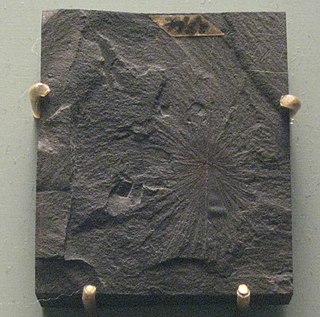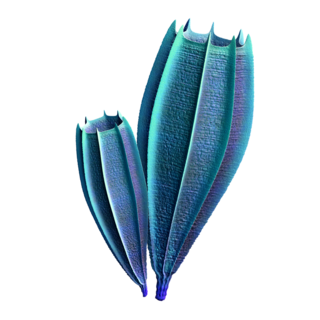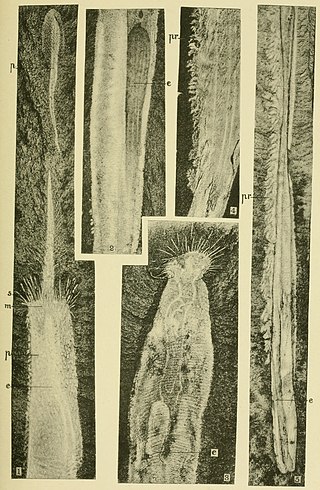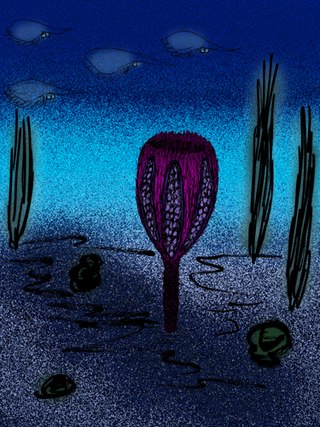
Choia is a genus of extinct demosponge ranging from the Cambrian until the Lower Ordovician periods. Fossils of Choia have been found in the Burgess Shale in British Columbia; the Maotianshan shales of China; the Wheeler Shale in Utah; and the Lower Ordovician Fezouata formation. It was first described in 1920 by Charles Doolittle Walcott.

Chancelloria is a genus of early animals known from the Middle Cambrian Burgess Shale, the Comley limestone, the Wheeler Shale, the Bright Angel Shale and elsewhere. It is named after Chancellor Peak. It was first described in 1920 by Charles Doolittle Walcott, who regarded them as one of the most primitive groups of sponges. However, they are currently thought to be member of the group Chancelloriidae. 178 specimens of Chancelloria are known from the Greater Phyllopod bed, where they comprise 0.34% of the community.
Crumillospongia is a genus of middle Cambrian sponges known from the Burgess Shale and other localities from the Lower and Middle Cambrian. Its name is derived from the Latin crumilla and spongia ("sponge"), a reflection of its similarity to a small leathery money purse. That is, it has a saclike shape, and its wall has holes of two sizes, with a well-developed internal canal system. 49 specimens of Crumillospongia are known from the Greater Phyllopod bed, where they comprise 0.1% of the community.

Takakkawia is a genus of sponge in the order Protomonaxonida and the family Takakkawiidae. It is known from the Middle Cambrian Burgess Shale that reached around 4 cm in height. Its structure comprises four columns of multi-rayed, organic spicules that align to form flanges. The spicules form blade-like structures, ornamented with concentric rings.
The Phyllopod bed, designated by USNM locality number 35k, is the most famous fossil-bearing member of the Burgess Shale fossil Lagerstätte. It was quarried by Charles Walcott from 1911–1917, and was the source of 95% of the fossils he collected during this time; tens of thousands of soft-bodied fossils representing over 150 genera have been recovered from the Phyllopod bed alone.
Cambrorhytium is an enigmatic fossil genus known from the Latham Shale (California), and the Chengjiang (China) and Burgess Shale lagerstätte. 350 specimens of Cambrorhytium are known from the Greater Phyllopod bed, where they comprise 0.7% of the community.

Eiffelia is an extinct genus of sponges known from the Middle Cambrian Burgess Shale as well as several Early Cambrian small shelly fossil deposits. It is named after Eiffel Peak, which was itself named after the Eiffel Tower. It was first described in 1920 by Charles Doolittle Walcott. It belongs in the Hexactinellid stem group. 60 specimens of Eiffelia are known from the Greater Phyllopod bed, where they comprise 0.11% of the community.

Falospongia is a genus of sponge made up of radiating fronds, known from the Middle Cambrian Burgess Shale. Its name is derived from the Latin fala ("scaffold") and spongia ("sponge"), referring to the open framework of the skeleton. It superficially resembles Haplistion but is monaxial. 5 specimens of Falospongia are known from the Greater Phyllopod bed, where they comprise under 0.1% of the community.
Fieldospongia is a genus of sea sponge known from the Middle Cambrian Burgess Shale. Just five specimens of Fieldospongia are known from the Greater Phyllopod bed, where they comprise less than 0.1% of the community.

Halichondrites, sometimes mis-spelt Halicondrites is an extinct genus of sea sponge known from the Middle Cambrian Burgess Shale. 7 specimens of Halichondrites are known from the Greater Phyllopod bed, where they comprise < 0.1% of the community.
Hamptonia is an extinct genus of sea sponge known from the Middle Cambrian Burgess Shale and the Lower Ordovician Fezouata formation. It was first described in 1920 by Charles Doolittle Walcott. 48 specimens of Hamptonia are known from the Greater Phyllopod bed, where they comprise < 0.1% of the community.
Mackenzia is an elongated bag-like animal known from the Middle Cambrian Burgess Shale. It attached directly to hard surfaces, such as brachiopod shells. 14 specimens of Mackenzia are known from the Greater Phyllopod bed, where they comprise <0.1% of the community. Mackenzia was originally described by Charles Walcott in 1911 as a holothurian echinoderm. Later, Mackenzia is thought to be a cnidarian and appears most similar to modern sea anemones.

Molaria is a genus of Cambrian arthropod, the type species M. spinifera is known from the Middle Cambrian Burgess Shale. 144 specimens of Molaria are known from the Greater Phyllopod bed, where they comprise 0.27% of the community. A second species M. steini was described from the Sirius Passet in Greenland in 2017.

Louisella is a genus of worm known from the Middle Cambrian Burgess Shale. It was originally described by Charles Walcott in 1911 as a holothurian echinoderm, and represents a senior synonym of Miskoia, which was originally described as an annelid. 48 specimens of Louisella are known from the Greater Phyllopod bed, where they comprise < 0.1% of the community. It has been stated to have palaeoscolecid-like sclerites, though this is not in fact the case.

Leptomitus is a genus of demosponge known from the Middle Cambrian Burgess Shale. Its name is derived from the Greek lept ("slender") and mitos ("thread"), referring to the overall shape of the sponge. 138 specimens of Leptomitus are known from the Greater Phyllopod bed, where they comprise 0.26% of the community.

Pagetia is a genus of small trilobite, assigned to the Eodiscinid family Pagetiidae and which had global distribution during the Middle Cambrian. The genus contains 55 currently recognized species, each with limited spatial and temporal ranges.

Pirania is an extinct genus of sea sponge known from the Middle Cambrian Burgess Shale and the Ordovician Fezouata formation. It is named after Mount St. Piran, a mountain situated in the Bow River Valley in Banff National Park, Alberta. It was first described in 1920 by Charles Doolittle Walcott. 198 specimens of Pirania are known from the Greater Phyllopod bed, where they comprise 0.38% of the community.

Petaloptyon danei is a goblet-shaped hexactinellid sponge known from rare fragments from the Middle Cambrian Burgess Shale. A few specimens of Petaloptyon are known from the Greater Phyllopod bed, where they comprise under 0.01% of the community.
Protospongia is a genus of Porifera known from the Middle Cambrian Burgess Shale. 102 specimens of Protospongia are known from the Greater Phyllopod bed, where they comprise 0.19% of the community.

Diagoniella is a genus of sponge known from the Middle Cambrian Burgess Shale. 128 specimens of Diagoniella are known from the Greater Phyllopod bed, where they comprise 0.24% of the community.












